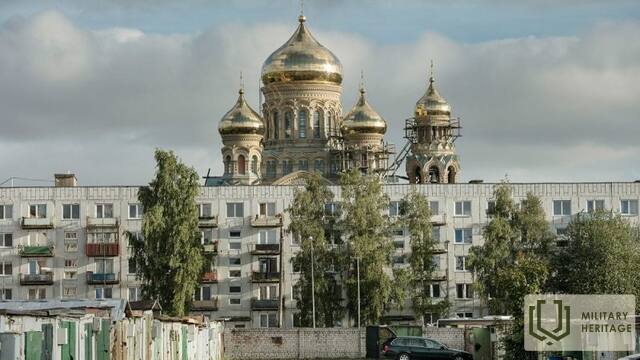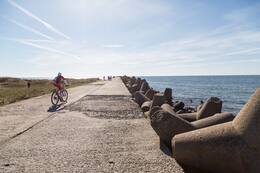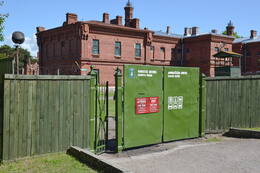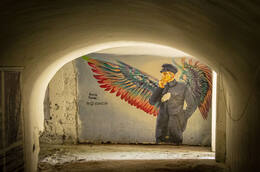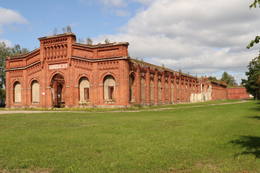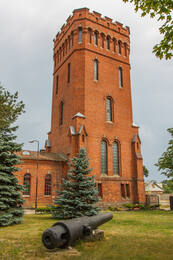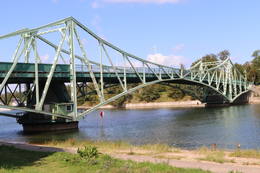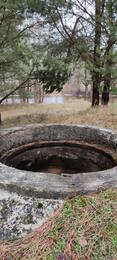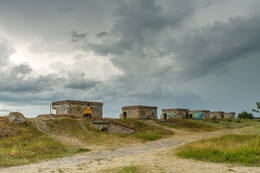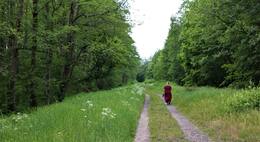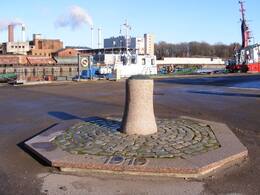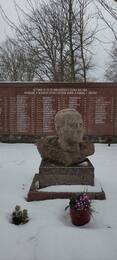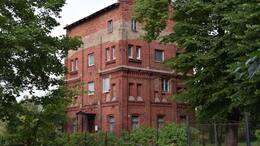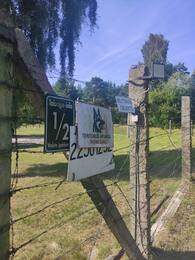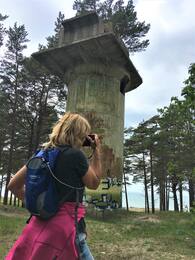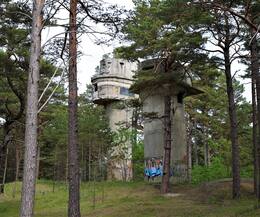Karosta Liepojoje
I WW1, I Nepriklausomybės karai, II Antrasis pasaulinis karas, IV Sovietų okupacija, III Nacionaliniai partizanai
Karosta istoriniu ir architektūriniu požiūriu yra unikali ne tik Latvijoje, bet ir pasaulyje.
Karosta yra didžiausia istorinė karinė teritorija Baltijos šalyse ir užima beveik trečdalį visos Liepojos teritorijos.
Ji buvo suprojektuota kaip visiškai autonominė gyvenvietė su savo infrastruktūra, elektros jėgaine, vandentiekiu, bažnyčia ir mokyklomis.
Karosta buvo pastatyta prieš Pirmąjį pasaulinį karą Rusijos kariuomenės reikmėms. Sovietmečiu Karosta buvo uždara teritorija, į kurią nebuvo įleidžiami net Liepojos civiliai gyventojai.
Paskutiniai sovietų armijos kareiviai iš Liepojos išvyko tik 1994 m.
Karostoje yra tokių karinio paveldo objektų kaip Šiaurinė prieplauka ir fortai, Redanas, Karostos kalėjimas, Karostos vandens bokštas, Šv. Nikolajaus stačiatikių jūros katedra, O. Kalpakos tiltas ir kt.
LANKYTINOS VIETOS KAROSTOJE:
Šv. Nikolajaus Jūrų katedra yra vienas iš Karostos simbolių. Ji buvo pastatyta 1903 m. kaip stačiatikių cerkvė, tačiau sovietų okupacijos metu joje ilgą laiką veikė „Matrose“ klubas. Raudonajai armijai pasitraukus, ji vėl yra stačiatikių katedra.
Šiaurinis molas saugo Liepojos uostą nuo šiaurės vakarų vėjų ir yra populiari pasivaikščiojimų bei žvejybos vieta. Šiaurinio molo ilgis yra 1800 metrų.
Redanas yra Liepojos tvirtovės dalis. Liepojos tvirtovė (fortai) buvo pastatyta XIX ir XX amžiuje. Fortai buvo pastatyti XIX amžių sandūroje, siekiant ginti Karostą ir visą Liepojos miestą užpuolimo atveju.
Manežas kadaise buvo puošiamas plačiais langais ir stiklinių čerpių stogu. Jis daugiausia buvo naudojamas kareivių pratyboms ir iškilmingiems susitikimams.
Vandens bokštas virš Karostos iškyla 37 metrus. Jis buvo pastatytas XX a. Vandens bokštas buvo pastatytas XX a. pradžioje, siekiant aprūpinti Karostą gėlu vandeniu.
O. Kalpakos posūkio tiltas jungia Karostą su likusia Liepojos dalimi. Metalo konstrukcijos tilto statyba buvo baigta 1906 m. ir nuo to laiko jis buvo kelis kartus rekonstruotas. Šiandien, kaip ir anksčiau, tiltas tam tikru paros metu atidaromas laivų eismui.
Daugiau informacijos šaltinių
Karas – „YouTube“
Karosta | LiepajaKelionės
Susijusi laiko juosta
Susijusios vietos
Šiaurinis molas ir 3-ioji baterija Karostoje
Ilgiausias molas Latvijoje – Šiaurinis molas – buvo pastatytas XIX a. pabaigoje kaip labai svarbi Liepojos jūros tvirtovės ir karinio uosto dalis. Molo ilgis – 1800 metrų, plotis – 7,35 metro.
Šiaurinis molas yra vienas pirmųjų imperatoriaus Aleksandro III uosto statinių, pastatytas 1890–1892 m., prieš kasant Karostos kanalą. Kartu su Šiauriniu molu, Pietiniu molu ir Pietiniu molu molas sudarė Liepojos užkampį.
Liepojos tvirtovės 3-ioji baterija buvo įsikūrusi šalia Karostos šiaurinio molo ir buvo planuojama, kad ji bus didžiausia ginkluotės atžvilgiu. Buvo pastatytos platformos keturiems 6 colių (152 mm) 1892 m. modelio „Canet“ sistemos pabūklams, penkiems 11 colių (280 mm) 1887 m. modelio pabūklams ir dviem 57 mm „Nordenfeld“ prieštankiniams pabūklams, taip pat 18 9 colių (229 mm) pabūklų ir minosvaidžių.
Šiandien 3-iąją bateriją labiausiai veikia vyraujanti pietų-šiaurės jūros srovė, kuri už Šiaurinio molo sukuria sūkurį, dėl kurio išplaunami patrankų platformos pamatai.
Šiaurinis molas saugo Liepojos uosto teritoriją nuo šiaurės vakarų vėjų. Tai mėgstama vieta Liepojos gyventojams ir lankytojams stebėti saulėlydžius, žvejoti ir stebėti jūrą įvairiomis oro sąlygomis. Ypač įspūdinga audrų metu.
Šiaurinėje prieplaukoje yra daug vietos automobiliams pastatyti. Taip pat yra tualetai ir kavinė su unikaliu vaizdu į jūrą.
Redanas, Karosta
Redanas, arba Redanos fortas, yra Karostoje, lapkričio 14 d. gatvėje, apie 1,5 km nuo Šiaurinių fortų, gamtos rezervate „Tosmare“.
Istoriškai redanai buvo įtvirtinimų elementai, kur ilgesnės tvirtovės sienų atkarpos buvo dalijamos į trumpesnes dalis, įrengiant V formos pozicijas, nukreiptas į priešą, taip geriau apsaugant įtvirtinimų sieną. Karosto redanas yra XIX a. pabaigos Liepojos jūros tvirtovė, išsikišusi link Tosmarės ežero. Tvirtovei praradus savo, kaip tvirtovės, vaidmenį, aplink ją esantys įtvirtinimai ir fortai buvo iš dalies susprogdinti ir paversti nebenaudotinais. Tačiau Redanas išliko beveik nepaliestas.
1919 m. lapkritį, po nesėkmės Rygoje, Pavelo-Bermonto Avalovo pajėgos pradėjo intensyvų Liepojos puolimą. Mūšis vyko ir Redane, kur kovojo 80 Liepojos karinio uosto komendantūros kareivių, vadovaujamų vado leitenanto Radzinio. Lapkričio 14 d. per greitą puolimą bermontininkams pavyko užimti Redaną. Po to sekė Latvijos kariuomenės kontrataka ir Redanas buvo atsiimtas.
Birželio, liepos ir rugpjūčio mėnesiais kiekvieną dieną nuo 11.00 iki 17.00 val. Redane jūsų lauks patyręs gidas, pasiruošęs papasakoti daugiau apie Liepojos tvirtovę ir istorinius įvykius Karostoje.
Karaostos manevras
Karostos maniežo griuvėsiai yra Karostoje, Žemgales gatvėje 2/12, tarp Zemgales, Burtnieku, Virssardzes ir Manēžas gatvių.
Iki Pirmojo pasaulinio karo kiekvieną sekmadienį manieže vykdavo kavalerijos, artilerijos ir vyresniųjų karininkų sportinių žirgų demonstracijos, o darbo dienomis – vyresniųjų karininkų kūno kultūros pamokos. Tai buvo didžiausia dengta salė Liepojoje, todėl joje taip pat vykdavo oficialūs priėmimai ir garbės pietūs garnizono vyresniosioms karininkėms. 1913 m., nuo sausio 13 d. iki balandžio 26 d., visoje Rusijoje buvo švenčiamos carų Romanovų dinastijos 300-osios valdymo metinės. 1913 m. vasario 21 d. pagrindinis šventės renginys buvo surengtas Liepojos garnizone, o abiejuose karininkų susirinkimų pastatuose (Karinio jūrų laivyno ir pėstininkų) vyko balius. Manieže karininkams buvo surengti šventiniai pietūs, kuriuose vienu metu prie stalų sėdėjo 4000 žmonių.
Manežas buvo statomas 1903–1904 m. Išskirtinis jo bruožas buvo stogas – labai lengvas, su kniedėmis pritvirtinta metaline konstrukcija, skardos danga ir stiklo čerpių juostelėmis. Kartu su didžiuliais arkiniais langais jis į patalpą patekdavo daug šviesos. Salė buvo asketiška – grindys buvo padengtos pjuvenomis. Manežas nukentėjo per Antrąjį pasaulinį karą, kai sudegė visa stogo konstrukcija. Po karo sovietų armija areną pradėjo naudoti kaip automobilių stovėjimo aikštelę ir sandėlį.
Šiandien matyti tik maniežo sienos, kurių langų angos sovietiniais metais užmūrytos.
Karostos vandens bokštas
Vandens bokštas yra Liepojoje, Karostoje, Generolo Baložos gatvėje 29 – ten, kur gatvė susikerta su Lazaretes gatve. Vandens bokštas buvo svarbus Karostos statinys, nes tiekdavo geriamąjį vandenį beveik visai Karostos teritorijai. Tikslus vandens bokšto statybos laikas nežinomas, tačiau jis galėjo būti pastatytas 1903–1905 metais. Projektą greičiausiai parengė Sankt Peterburgo architektas Stefanas Galenzovskis.
Vandens bokštą varė garo variklis su dviem anglimi kūrenamais katilais, vienas iš jų buvo laikomas rezerve, todėl šalia bokšto yra tokio pat aukščio kaminas. Transmisija varė keturis siurblius, iš kurių du buvo laikomi rezerve. Keturi gręžiniai tiekdavo vandenį siurbliams, kurie pumpuodavo jį į rezervuarą penktame bokšto aukšte, o iš ten – į karininkų butus ir kareivinių kareivines Karostoje.
Latvijos armijai perėmus vandens bokšto valdymą, vandens bokšto valdymą perėmė ir Karo ministerija. Po Antrojo pasaulinio karo valdymą perėmė Sovietų armija. Vandens bokštas uždarytas nuo 1989 m.
Nors bokštas nebuvo karinis statinys, 1919 m. lapkritį Latvijos armija atitaisė britų karo laivų artilerijos ugnį kovoje su Bermonto kariuomenės puolimu.
https://industrialheritage.travel/lv/objects/karostas-udenstornis/51
Karostos Šv. Nikolajaus stačiatikių jūros katedra
Šv. Nikolajaus stačiatikių Jūros katedra yra vizualinis ir dvasinis Karostos akcentas, ryškus kontrastas su šalia pastatytais aukštybiniais surenkamaisiais namais. Bažnyčia buvo suprojektuota ir pastatyta pagal XVII a. rusų stačiatikių cerkvių principą – su vienu centriniu ir keturiais šoniniais kupolais.
Imperatoriui Aleksandrui III projektuojant uosto kompleksą, jau buvo numatyta reprezentacinė katedra, tačiau iš pradžių prioritetas buvo teikiamas uosto infrastruktūrai. Nuo pat pradžių uosto ligoninės teritorijoje veikė laikina stačiatikių cerkvė.
Jūrų Šv. Nikolajaus katedros statyba pradėta 1900 m. pagal architekto Vasilijaus Kasjakovo projektą, kuris buvo labai panašus į kitus to meto Rusijos imperijos sakralinius pastatus. Katedra buvo pašventinta 1903 m. rugpjūčio 22 d., joje dalyvavo Rusijos imperatorius Nikolajus II su šeima. Iki 1915 m. katedroje vykdavo visi Rusijos armijos ir karinio jūrų laivyno iškilmingi renginiai, įskaitant 2-osios Ramiojo vandenyno eskadrilės tarnybą 1904 m., prieš jai išplaukiant į Tolimuosius Rytus, kur ji buvo sunaikinta Cušimos mūšyje.
Po 1915 m., kai Liepoją okupavo vokiečių kariuomenė, katedra išlaikė savo sakralinį statusą ir iš dalies savo įrangą, joje vykdavo retos pamaldos.
Latvijos armijai įgulus Liepojoje Karostos teritorijoje, katedra toliau veikė kaip stačiatikių bažnyčia iki 1934 m., kai ji buvo paversta liuteronų bažnyčia Liepojos garnizonui. Bažnyčia buvo perdažyta, įskaitant kryžių pakeitimą, ir trys pagrindinės konfesijos – liuteronų, katalikų ir stačiatikių – galėjo joje laikyti pamaldas. Katedroje buvo išsaugotas vienas stačiatikių altorius, o XX a. 4-ojo dešimtmečio pabaigoje liuteronų pamaldoms buvo įrengti VEF pagaminti elektriniai vargonai.
1939–1941 m., sovietų karinės bazės metu, katedra prarado sakralinį statusą, o Antrojo pasaulinio karo metu pastatu taip pat naudojosi įvairūs vokiečių daliniai.
Po Antrojo pasaulinio karo sovietų karinio jūrų laivyno bazės vadovybė katedroje įkūrė motinų klubą, o pastatas buvo pritaikytas naujai funkcijai.
1991 m. rugsėjį, dar veikiant Rusijos Federacijai, katedra buvo atkurta ir išsaugota iki istorinio pavadinimo bei perduota Stačiatikių bažnyčiai. Pirmosios pamaldos įvyko 1991 m. gruodžio 19 d. Šv. Nikolajaus garbei. 2016 m. rugsėjį buvo pašventinti restauruoti katedros varpai.
Oskaro Kalpako tiltas Karostoje
Oskaro Kalpakos vardu pavadintas tiltas yra Liepojos vartai į Karostą ir yra Oskaro Kalpakos ir Atmodos gatvių sankryžoje – kitoje Karostos kanalo pusėje.
Unikalus pasukamasis tiltas buvo atidarytas 1906 m. rugpjūčio 19 d. Tiltas buvo susprogdintas Pirmojo pasaulinio karo metu, tačiau po karo atstatytas. Tiltas buvo atstatytas po to, kai 1926 m. jį apgadino garlaivis „Narne“, tačiau jis nukentėjo ir Antrojo pasaulinio karo metu, kai įsiveržusi sovietų armija apšaudė Liepojos uostą. Iki Latvijos Respublikos nepriklausomybės atkūrimo Karosta buvo uždara Liepojos teritorija, neprieinama net Liepojos gyventojams. Visa Karosta buvo karinis objektas, todėl eismą per tiltą visą parą kontroliavo sargybos postai. Pereiti per tiltą į Karostą buvo galima tik gavus specialius leidimus kelias valandas per dieną, likusį laiką tiltas buvo atviras sovietinių karo laivų eismui. Visus okupacijos metus tiltas buvo vadinamas „Raudonosios armijos tiltu“. 2006 m. vasarą į šiaurinę tilto atramą įskrido tanklaivis su Gruzijos vėliava „Anna“, o po rekonstrukcijos Oskaro Kalpakos tiltas oficialiai atidarytas 2009 m. rugpjūtį.
Tiltas sveria 300 tonų ir susideda iš dviejų dalių (šiaurinės ir pietinės pusių), pagamintų iš dviejų identiškų konsolių. Tilto važiuojamosios dalies plotis yra 7,3 metro, o platforma – iš medinių lentų. Bendras tilto ilgis – 133 metrai, o tarpatramis – 27,55 metro + 77,9 metro + 27,55 metro. Tilto aukštis virš vandens lygio – 8,32 metro. Tiltas kertamas nustatytu laiku, ir, vadovaujantis Uosto saugos taisyklėmis, laivas gali pradėti eismą tik tada, kai tiltas yra atidarytas laivų eismui ir yra saugu įplaukti į Karostos kanalą arba išplaukti iš jo. Oskaro Kalpakos tiltas laivų eismui grąžinamas 5 kartus per dieną. Tiltas nustatytu laiku nekertamas, jei vėjo greitis viršija 10 m/s arba jei neplanuojami manevrai.
Kapralo Narkēvičiaus apkasas
Kapralo Narkēvico restauruoti kasinėjimai yra visai šalia Cietokšnio kanalo ir juos galima apžiūrėti tiek atskirai, tiek palei Karostos Laisvės taką.
Apkasų vieta, iš kurios Latvijos armijos kapralas Vilis Narkēvics šautuvu (lengvuoju kulkosvaidžiu) saugojo Škėdės tiltą. Kapralas Narkēvičs buvo ginkluotas iš britų įsigytu 7,69 mm kalibro Lewis automatiniu šautuvu (lengvuoju arba rankiniu kulkosvaidžiu). Dėtuvėje buvo 97 šoviniai, todėl tai buvo sunkus (beveik 12 kg) ginklas, bet efektyvus. Kapralo Vilio Narkēvicso patirtis, įgyta Antrojo pasaulinio karo frontuose, ir taiklus kulkosvaidžio šaudymas lėmė pergalę mūšyje. Jam buvo įteiktas Latvijos ginkluotųjų pajėgų riterių ordino karinis ordinas.
NBS kariai ir kariai kapralo Narkēvico pareigas atkūrė 2017 m. balandžio mėn.
Liepojos šiaurinis fortas ir 1-oji baterija Karostoje
Šiauriniai fortai yra geriausiai žinoma ir vizualiai įspūdingiausia Liepojos tvirtovės dalis. Juos XIX a. pabaigoje pastatė Rusijos caro armija, o istorinis jų pavadinimas – 1-oji tvirtovės baterija.
1908 m. lapkritį, praėjus mažiau nei 10 metų po Liepojos tvirtovės pastatymo, ji nustojo veikti, nes jos statyba buvo pripažinta strategine klaida. Dalis patrankų buvo išardytos ir išvežtos į Kauno tvirtovę Lietuvoje, o kitos – išlydytos. Fortifikaciniai statiniai buvo du kartus susprogdinti, siekiant sunaikinti įtvirtinimus. Iki šių dienų išlikusios detalės yra sprogimų metu nevisiškai sunaikintos artilerijos baterijos ir požeminiai statiniai. Kaip ir Karosta, Šiauriniai fortai sovietų okupacijos metu buvo uždara karinė teritorija. Šiaurinių fortų lankytojai turėtų būti labai atsargūs. Kaip ir kitose Latvijos pakrantės vietose, status Baltijos jūros krantas Karostoje yra pavojingas dėl galimų pakrantės nuošliaužų. Todėl po fortų griuvėsiais vaikščioti draudžiama.
Šiaurinėje tvirtovės dalyje buvo įsikūrusi viena iš keturių pakrantės gynybos baterijų – 1-oji baterija. Baterijoje turėjo būti šešios 6 colių (152 mm) 1892 m. modelio „Canet“ sistemos patrankos, šešios 11 colių (280 mm) 1887 m. modelio patrankos ir dvi 57 mm „Nordenfeld“ priešlaivinės patrankos. Tik „Canet“ sistemos patrankos turėjo pakankamai ilgą šaudymo nuotolį, kad atlaikytų galimą Vokietijos karinio jūrų laivyno apšaudymą. Taigi, likviduojant tvirtovę, ginkluotė buvo sumontuota tik iš dalies.
Laisvės takas (Karostos maršrutas)
Gerai prižiūrimas 9 km ilgio pėsčiųjų takas, sukurtas Latvijos vyrų drąsai ir didvyriškumui atminti 1919 m. Latvijos laisvės kovos metu.
Takas prasideda Redanoje ir driekiasi per Karostos miškų teritoriją, pajūriu ir Cietokšnios kanalu, aplankant caro laikų įtvirtinimus ir sovietmečio karinį paveldą. Take yra 5 informaciniai stendai, kuriuose supažindinama su Karostos ir visą miestą juosiančios įtvirtinimų sistemos sukūrimu, 1919 m. Liepojos Laisvės mūšiais, vėlesniais metais pastatytais kariniais statiniais ir gyvenimu Karostoje sovietmečiu.
1918 m. lapkričio 18 d. buvo paskelbta nepriklausoma Latvijos Respublika, tačiau naujai įkurtos Latvijos valstybės teritorijoje vis dar buvo dislokuoti keli užsienio kariai.
1919 m. lapkritį įvykęs Liepojos mūšis suvaidino svarbų vaidmenį atgaunant Latvijos laisvę, kai karių didvyriškumo dėka priešas buvo pralaimėtas beveik 5 kartus. Po lemiamų mūšių Liepojoje Bermontas buvo išvarytas iš Latvijos.
Laivo „Saratov“ prieplauka Liepojoje
„Saratov“ prieplauka yra Liepojoje, Senojoje uoste, 59, netoli laivų prieplaukos.
Pastatytas 1888 m. Kopenhagoje laivų statyklos „Buvmeistar & Wain“ pavadinimu „Leopold II“, 1911 m. jį įsigijo akcinė bendrovė „Russian North-West Shipping“ ir pervadino į „Saratov“, o laivo kapitonu tapo latvis Aleksandras Remessas.
1915 m. gegužę, kai Liepoją okupavo vokiečių kariuomenė, laivas „Saratovas“ uoste buvo apgadintas.
1919 m. sausio 10 d. garlaivį „Saratov“ perėmė Latvijos laikinoji vyriausybė. Nuo 1919 m. balandžio iki liepos mėn., po „balandžio 16 d. perversmo“, K. Ulmanio vadovaujama laikinoji vyriausybė buvo „Saratov“ laive ir buvo priversta slėptis sąjungininkų laivyno globoje.
1919 m. liepos 8 d., laikinajai K. Ulmanio vyriausybei perdavus Rygą, garlaiviai buvo naudojami susisiekimui tarp Rygos, Ventspilio ir Liepojos.
Pagal 1920 m. rugpjūčio 11 d. Latvijos ir Sovietų Rusijos taikos sutarties sąlygas garlaivis „Saratovas“ turėjo būti grąžintas Sovietų pusei. 1923 m. sausio 2 d. garlaivis buvo perduotas Sovietų Rusijos atstovui. 1923 m. sausio 15 d. garlaivis „Saratovas“ sudužo prie Akmenrago krantų.
1936 m. Latvijos jūrų departamentas pardavė nuolaužas įmonei, kuri jas sutvarkė ir perdavė Liepojos audinių fabrikui.
Paminklas žuvusiems žvejams, jūreiviams ir JAV lakūnams
250 metrų į pietvakarius nuo 6-osios baterijos yra Žvejų ir jūreivių paminklas su lenta, skirta JAV karinio jūrų laivyno žvalgybiniam lėktuvui PB4Y-2 Privateer, numuštam prie Liepojos 1950 m. balandžio 8 d. Lėktuvas, pravarde „Turbulentinis vėžlys“, priklausė 26-ajai patrulių eskadrilei ir pakilo iš Vysbadeno aerodromo balandžio 8 d. ankstyvą rytą ir per Kopenhagą išvyko į stebėjimo ir galbūt radijo žvalgybos misiją. Pagal įsakymą lėktuvas negalėjo priartėti prie Kuršo pakrantės arčiau nei 20 jūrmylių, tačiau dėl nežinomos priežasties jis įskrido į SSRS pačios nustatytą 12 jūrmylių zoną. Du sovietų 30-ojo gvardijos naikintuvų pulko La-11 perėmė ir numušė neginkluotą žvalgybinį lėktuvą. Numušto lėktuvo 10 narių įgulos likimas nėra tiksliai žinomas; yra prieštaringų žinių, kad visi pilotai žuvo arba kad kai kurie pilotai išgyveno ir pateko į karo belaisvių stovyklas.
Įgula:
AT1 Frank L. Beckman
AL3 Joseph J. Bourassa
ENS Tommy L. Burgess
1 m. po Kr. Joseph H. Danens
Leitenantas Johnas H. Fette'as
CT3 Edwardas J. Purcellas
LTJG Robertas D. Reynoldsas
AN Joseph N. Rinnier
Leitenantas Howardas W. Seeschafas
1 m. po Kr. Jackas W. Thomasas
Paminklas žuvusiems žvejams, jūreiviams ir JAV lakūnams
250 metrų į pietvakarius nuo 6-osios baterijos yra Žvejų ir jūreivių paminklas su lenta, skirta JAV karinio jūrų laivyno žvalgybiniam lėktuvui PB4Y-2 Privateer, numuštam prie Liepojos 1950 m. balandžio 8 d. Lėktuvas, pravarde „Turbulentinis vėžlys“, priklausė 26-ajai patrulių eskadrilei ir pakilo iš Vysbadeno aerodromo balandžio 8 d. ankstyvą rytą ir per Kopenhagą išvyko į stebėjimo ir galbūt radijo žvalgybos misiją. Pagal įsakymą lėktuvas negalėjo priartėti prie Kuršo pakrantės arčiau nei 20 jūrmylių, tačiau dėl nežinomos priežasties jis įskrido į SSRS pačios nustatytą 12 jūrmylių zoną. Du sovietų 30-ojo gvardijos naikintuvų pulko La-11 perėmė ir numušė neginkluotą žvalgybinį lėktuvą. Numušto lėktuvo 10 narių įgulos likimas nėra tiksliai žinomas; yra prieštaringų žinių, kad visi pilotai žuvo arba kad kai kurie pilotai išgyveno ir pateko į karo belaisvių stovyklas.
Įgula:
AT1 Frank L. Beckman
AL3 Joseph J. Bourassa
ENS Tommy L. Burgess
1 m. po Kr. Joseph H. Danens
Leitenantas Johnas H. Fette'as
CT3 Edwardas J. Purcellas
LTJG Robertas D. Reynoldsas
AN Joseph N. Rinnier
Leitenantas Howardas W. Seeschafas
1 m. po Kr. Jackas W. Thomasas
Liepojos tvirtovės pietinis fortas ir paminklas N. Dedajevui, Raudonosios armijos 67-osios šaulių divizijos vadui
Liepojos tvirtovės Pietinis fortas yra pietvakarinėje Liepojos dalyje, tarp Klaipėdos gatvės ir paplūdimio.
Buvo planuojama pastatyti fortą imperatoriaus Aleksandro III uosto apsaugai iš pietų, du kilometrus nuo pietinės miesto sienos. Fortas turėjo būti tarp Liepojos ežero ir jūros, į vakarus nuo Perkūno upės žiočių, o gelžbetoninius įtvirtinimus sutvirtinti grioviu. Nors įtvirtinimai buvo beveik visiškai baigti, ginkluotė dar nebuvo dislokuota. Pastatyti rūsiai buvo naudojami kaip sandėliai tiek Pirmojo, tiek Antrojo pasaulinio karo metu. XX a. 3-ajame ir 4-ajame dešimtmečiuose įtvirtinimų teritorijoje buvo įsikūrusios įvairios gamyklos. Skirtingai nuo Viduriniojo forto ir Ravelino, Pietinis fortas niekada nedalyvavo kare, nes visuose karuose užpuolikai buvo apgulę Liepojos ežero rytinę pakrantę ir bandė įsiveržti į Liepoją tarp Tosmarės ir Liepojos ežerų.
Į šiaurę nuo Pietinio forto yra didžiausios Liepojos kapinės – Centrinės. Pietinėje kapinių dalyje yra Raudonosios armijos kapinės, kuriose perlaidoti Liepojos apylinkėse žuvę sovietų kariai, tarp jų ir 67-osios šaulių divizijos vadas generolas majoras Nikolajus Dedajevas, vadovavęs Liepojos gynybai 1941 m. birželį.
Karvelių pašto jūrų stotis Karostoje
Buvusi karinio jūrų laivyno balandžių stotis Nr. 2 – iš tikrųjų veisimo stotis – yra Karostoje, Pulkveža Brieža gatvėje 6. Ji buvo pastatyta 1899–1900 m. ir buvo skirta apgyvendinti apie 450 pašto balandžių – sparnuotųjų karių. Vėlesniais metais pastatas buvo pertvarkytas į butus, todėl išliko tik raudonų plytų pastato korpusas. Kita pašto balandžių stotis, Nr. 1, kuri neišliko, buvo skirta 750 sausumos karių naudojimui ir buvo įsikūrusi Atmodas bulvaro šiauriniame gale.
Pašto balandžiai buvo paprastas, greitas ir patikimas būdas užtikrinti ryšį tarp kranto ir laivų jūroje. Nors radijo telegrafas, kaip moderni ryšio priemonė, tuo metu jau buvo plačiai naudojamas, balandžių naudojimas buvo laikomas saugesniu – priešas galėjo perimti pranešimą tik perimdamas patį pašto balandį. Pašto balandžiai judėjo vidutiniu 60 km per valandą greičiu, tačiau palankiomis vėjo sąlygomis jie galėjo judėti iki 100 km per valandą greičiu. Balandžius reikėjo specialiai paruošti ir apmokyti, todėl su jais elgtis reikėjo atsargiai ir kantrybės. Pašto balandžio ryšys veikė per paukščių gebėjimą grįžti į savo namų narvelį. Kai paukštis buvo perkeltas į kitą vietą – balandžių stotį, paleidimo ir paleidimo punktą – ir paleistas su pranešimų kapsule, mažasis pasiuntinys grįždavo į savo namų narvelį. Siekiant užtikrinti ryšį tarp dviejų balandžių stočių, kiekvienoje reikėjo laikyti tam tikrą skaičių paukščių, kurie buvo užaugę korespondento ryšio, arba pašto balandžių, stotyje. Kiekvienais metais balandžiai dalyvaudavo įvairiuose manevruose ir varžybose. Taip pat po Latvijos nepriklausomybės, nuo 1920 iki 1940 m., Liepojoje buvo įsikūrusi Latvijos armijos Kuršo divizijos pašto balandžių stotis, kuri galėjo susisiekti tiek su Ryga, tiek su Daugpiliu. Tarpukariu į Latvijos teritoriją taip pat atklydo pašto balandžiai iš Vokietijos, Lenkijos, Lietuvos, Suomijos ir Estijos. Balandžiai iš Latvijos staiga buvo aptikti ir kaimyninėse šalyse.
Pastatas per daugelį metų buvo kelis kartus perstatytas ir dabar yra gyvenamasis pastatas. Tačiau išskirtinė pastato forma, pastatyta iš raudonų plytų, būdingų seniesiems Karostos pastatams, vis dar aiškiai matoma iš išorės.
Liepojos pakrantės artilerijos baterija Nr.2
Tarp daugelio Liepojos jūrų muziejaus eksponatų, Liepojos pakrantės artilerijos baterija Nr. 2 iki šiol yra paslaptingiausia vieta Liepojoje. Antrojoje baterijoje visada buvo įrengti įvairių valstybių karių šaudmenų sandėliai.
Liepojos tvirtovės 2-oji baterija buvo pastatyta toliau nuo pakrantės ir buvo apsaugota aukšta įtvirtinimų siena. Baterija buvo ginkluota 16 11 colių (280 mm) minosvaidžių, pagamintų 1877 m. modelio. Išardžius tvirtovę, čia buvo įrengti šaudmenų sandėliai. Dėl sprogimo pavojaus teritorija 130 metų buvo uždaryta visuomenei, saugoma, tačiau dabar čia įrengta paroda apie 1-ojo Kuršo divizijos štabo veiklą 1919–1940 m., taip pat eksponuojami 1-ojo Liepojos pėstininkų pulko, 2-ojo Ventspilio pėstininkų pulko ir Kuršo artilerijos pulko fotografiniai įrodymai.
23-iosios Kranto baterijos pirmasis tolimatis (1941 m.)
Tolimačiai (datuojami 1941 m.) yra kopos pušyse, vos už 10 m nuo kito bokšto, pastatyto 1954 m. Kranto baterijos 1-oji ir 2-oji patrankų pozicijos yra pajūryje ir iš dalies eroduotos, o 4-oji patrankų pozicija geriausiai matoma kopose. Pabūklus aptarnavusių personalo gelžbetoninis bunkeris dabar nuplautas bangų ir turi išplautus pamatus, pasvirusius ir pasvirusius į jūrą.
Liepojos tvirtovės 2-oji baterija buvo planuojama statyti toliau nuo kranto linijos ir apsaugoti aukštu pylimu. Baterijos ginkluotė turėjo būti 16 11 colių (280 mm) minosvaidžių, pagamintų 1877 m. modelio. Minosvaidžiai turėjo taikyti stačias trajektorijas ir nereikalavo tiesioginio taikymo.
Pagal 1939 m. spalio 5 d. pasirašytą Latvijos Respublikos ir SSRS „bazių susitarimą“, Kuržemėje turėjo būti dislokuotas beveik 25 000 Raudonosios armijos ir Baltijos karinio jūrų laivyno karių kontingentas. Iki 1941 m. kovo mėn. Latvijoje, Irbės įlankos, Saremos ir Liepojos gynybos sektoriuose, buvo įkurtos Baltijos šalių karinio jūrų laivyno bazės, kurias sudarė pakrantės gynybos baterijos.
Liepojos pakrantės gynybos sektorių sudarė 208-oji artilerijos divizija su dviem 130 mm B-13 patrankų baterijomis (Nr. 23 ir Nr. 27) ir viena 180 mm bėginių patrankų baterija. 23-iosios baterijos statyba prasidėjo 1939 m. lapkritį ir buvo baigta 1941 m. gegužės 17 d., iš dalies panaudojant Liepojos tvirtovės 2-osios baterijos gelžbetoninius įtvirtinimus. 23-iąją bateriją sudarė keturios gelžbetoninės patrankų pozicijos pakrantėje, vadovavimo postas ir stebėjimo (atstumo matavimo) bokštas kopų miške. Atstumo matavimo pozicijos buvo išdėstytos gelžbetoniniuose bokštuose, siekiant užtikrinti geresnį matomumą ir kartu išlaikant paslėptą vietą pušyne.
Po Antrojo pasaulinio karo 23-ioji baterija buvo pervadinta į 636-ąją ir ginkluota tais pačiais 130 mm B-13 pabūklais, o 1954 m., greta 1941 m. bokšto, ugnies valdymui buvo pastatytas naujas šaudymo bokštas. 1963 m. buvo išardytos visos Liepojos pakrantės gynybos pabūklai.
Atkūrus Latvijos nepriklausomybę, 2-osios baterijos rajonas priklauso Gynybos ministerijai.
23-iosios Kranto baterijos antrasis tolimatis (1954 m.)
Tolimatis (datuojamas 1954 m.) yra kopos pušyse, 10 m atstumu nuo 1941 m. tolimačio. Kranto baterijos 1-ojo ir 2-ojo patrankų pozicijos yra pakrantėje ir iš dalies eroduotos, o 4-ojo patrankos pozicija geriausiai matoma kopose.
Liepojos tvirtovės 2-oji baterija buvo planuojama statyti toliau nuo kranto linijos ir apsaugoti aukštu pylimu. Baterijos ginkluotė turėjo būti 16 11 colių (280 mm) minosvaidžių, pagamintų 1877 m. modelio. Minosvaidžiai turėjo taikyti stačias trajektorijas ir nereikalavo tiesioginio taikymo.
Pagal 1939 m. spalio 5 d. pasirašytą Latvijos Respublikos ir SSRS „bazių susitarimą“, Kuržemėje turėjo būti dislokuotas beveik 25 000 Raudonosios armijos ir Baltijos karinio jūrų laivyno karių kontingentas. Iki 1941 m. kovo mėn. Latvijoje, Irbės įlankos, Saremos ir Liepojos gynybos sektoriuose, buvo įkurtos Baltijos šalių karinio jūrų laivyno bazės, kurias sudarė pakrantės gynybos baterijos.
Liepojos pakrantės gynybos sektorių sudarė 208-oji artilerijos divizija su dviem 130 mm B-13 patrankų baterijomis (Nr. 23 ir Nr. 27) ir viena 180 mm bėginių patrankų baterija. 23-iosios baterijos statyba prasidėjo 1939 m. lapkritį ir buvo baigta 1941 m. gegužės 17 d., iš dalies panaudojant Liepojos tvirtovės 2-osios baterijos gelžbetoninius įtvirtinimus. 23-iąją bateriją sudarė keturios gelžbetoninės patrankų pozicijos pakrantėje, vadovavimo postas ir stebėjimo (atstumo matavimo) bokštas kopų miške. Atstumo matavimo pozicijos buvo išdėstytos gelžbetoniniuose bokštuose, siekiant užtikrinti geresnį matomumą ir kartu išlaikant paslėptą vietą pušyne.
Po Antrojo pasaulinio karo 23-ioji baterija buvo pervadinta į 636-ąją ir ginkluota tais pačiais 130 mm B-13 pabūklais, o 1954 m., greta 1941 m. bokšto, ugnies valdymui buvo pastatytas naujas šaudymo bokštas. 1963 m. buvo išardytos visos Liepojos pakrantės gynybos pabūklai.
Atkūrus Latvijos nepriklausomybę, 2-osios baterijos rajonas priklauso Gynybos ministerijai.
Susijusi istorija
Apie Liepojos tvirtovės patrankas
Šiaurinėje tvirtovės dalyje buvo viena iš keturių pakrantės gynybos baterijų – 1-oji baterija, tačiau tvirtovės likvidavimo metu jos ginkluotė nebuvo pilnai sumontuota.
O. Kalpako tilto istorija
Per daugiau nei 100 savo gyvavimo metų tiltas išgyveno du karus ir skirtingus savininkus, o tai turėjo įtakos jo eksploatacijai. Tiltas buvo susprogdintas per Pirmąjį pasaulinį karą, tačiau po karo atstatytas, o 1926 m. jį vėl apgadino garlaivis „Narne“. Tiltas buvo atstatytas dar kartą, tačiau nukentėjo ir Antrojo pasaulinio karo metu, kai įsiveržusi sovietų armija apšaudė Liepojos uostą.
Sovietų aviacijos antskrydžiai Liepojos priemiestyje 1944 m. spalio ir gruodžio mėn
Antrojo pasaulinio karo pabaigoje Vokietijos pajėgos Kurše galėjo sėkmingai gintis septynis mėnesius, nes Vokietijos karinis jūrų laivynas išlaikė kovinį pajėgumą iki Antrojo pasaulinio karo pabaigos ir aprūpino armijų grupę „Šiaurė“, o vėliau ir armijų grupę „Kuržemė“. Pagrindinis uostas buvo Liepoja, per kurią buvo pristatoma ir gabenama 80 % visų krovinių. Taigi Liepoja tapo svarbiu sovietų Baltijos karinio jūrų laivyno ir tolimojo nuotolio aviacijos taikiniu.
Generolo majoro N. Dedajevo sužalojimas Liepojos tvirtovėje, Viduso forte
1941 m. birželį sėkmingas vokiečių armijos puolimas pasiekė Liepoją, kai Liepoją puolė Vokietijos šarvuočių 291-oji pėstininkų divizija. Kai 1941 m. birželį prasidėjo karo veiksmai tarp nacistinės Vokietijos ir Sovietų Sąjungos, sovietų armijos Liepojos garnizoną sudarė Liepojos jūrų bazės ir Raudonosios armijos kariai. Šių mūšių metu generolas majoras N. Dedajevas buvo mirtinai sužeistas.
Redano mūšis 1919 m. lapkritį
Donatas Pudulis buvo Liepojos karinio uosto komendantūros seržantas, 1919 m. lapkričio 14 d. gavęs Ardėnų mūšio ordiną už drąsą ir narsą, kai, priešui užpuolus Redano fortą, perėmė komendanto kuopos vadovavimą iš mirtinai sužeisto vado leitenanto Roberto Radzinio ir greito kontratakavimo metu išvijo priešą iš forto, paimdamas 8 belaisvius ir 2 veikiančius kulkosvaidžius. Įdomus jo gyvenimas iki Liepojos mūšio. Būdamas 16 metų, 1911 m. jis savanoriškai įstojo į Sibiro šaulių pulką. 1914 m. jis dalyvavo mūšiuose su vokiečių armija Varšuvoje, Lodzėje ir kitur Lenkijos fronte, vėliau – mūšiuose su Austrijos armija. 1915 m. jis per Vladivostoką išplaukė į Prancūziją kaip Rusijos ekspedicinio korpuso dalis ir 4 mėnesius kovojo Verdune. 1917 m. pradžioje jis įstojo į Latvijos šaulių pulkus, o 1919 m. balandžio 7 d. – į Latvijos ginkluotąsias pajėgas Liepojoje.
Karosta – vokiško He-111 nusileidimo vieta Liepojos paplūdimyje 1939 m.
1939 m. rugsėjo 11 d. vokiečių bombonešis „Henkel He-111“, reidavęs Lenkijos miestus, naktį nukrypo nuo kurso ir avariniu būdu nusileido Liepojos paplūdimyje. Šis įvykis aprašytas Liepojos gyventojo ir Kuržemės divizijos ryšių kuopos karininko Vilio Zobenso atsiminimuose. Nusileidimo vieta gamtoje nepažymėta. Apytikslės koordinatės yra N 56.59368° E 21.01598° – paplūdimyje netoli Šiaurinių fortų.
Liepoja – įvairių istorinių įvykių kryžkelėje
Liepojos gyventojai buvo vieni pirmųjų Latvijoje, patyrusių Antrojo pasaulinio karo protrūkį, ir vieni paskutiniųjų, kuriems karas baigėsi tiek tiesiogine, tiek simboliška prasme. Antrasis pasaulinis karas ir sovietų okupacija Liepojoje baigėsi tik 1994 m., kai iš miesto paliko paskutiniai SSRS įpėdinės Rusijos kariai.
Apdovanojimo skyrimo šarvuoto traukinio vadui A. Klestrovui priežastys
Sėkmingai atremdamas priešo ataką, ginkluoto traukinio vadas A. Klestrovas žuvo, o pulkininkas Dankeris išdavė apdovanojimo pagrindą.
Stebuklingas pulkininko leitenanto Eduardo Graudino išsigelbėjimas nuo sušaudymo
1944 m. lapkritį vokiečių okupacinės valdžios karo teismas nuteisė 8 generolo Kurelio grupės štabo karininkus, trims štabo karininkams dėl įvairių priežasčių buvo suteikta malonė. Pulkininkui leitenantui pavyko išvengti sušaudymo, tačiau Graudinį „sutrypė“ vokiečių koncentracijos stovyklų sistema.
Karostos unikalaus karinio objekto istorija
Jau daugelį metų nepastebėjau jokio nuolatinio Senosios Liepojos gyventojų susidomėjimo unikaliomis vietomis, esančiomis vos už aštuonių–dešimties kilometrų į šiaurę nuo miesto centro. Tačiau miško tankmėje, kopų šlaite ar pelkių takuose pasislėpusios istorinės Karostos vietos yra ne mažiau įdomūs istoriniai faktai ir istorijos, vertos seniai pamirštų legendų. Viena iš jų – buvusi 23-oji SSRS pakrantės artilerijos baterija – ir bus šio pasakojimo tema.




